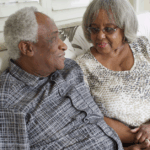If you’ve never heard of amyloid light chain amyloidosis (AL amyloidosis, for short), don’t be surprised. It’s a rare blood cell disorder that about 4500 people are diagnosed with each year.1
Because rare diseases are so…well, rare, available research about the diseases doesn’t often include information about Black populations. Such is the case with AL amyloidosis.
Based on what we know about closely related blood cell disorders like multiple myeloma — which is twice as common in Black people than whites2 — it’s important for more research to reflect Black populations.
It’s also crucial for Black folks to be more aware of AL amyloidosis, including what it is, what their risk factors are, and what treatments are best for them.
What is amyloidosis?
Amyloidosis (pronounced “am-uh-loy-DOH-sis”) is a broad set of diseases, and there are multiple types. For example, ATTR amyloidosis is another type of amyloidosis that happens when there’s a change in a person’s transthyretin (TTR) gene. ATTR amyloidosis can be hereditary but it isn’t always. It most commonly affects the heart and is sometimes called cardiac amyloidosis.3
While there are many different types of amyloidosis, AL amyloidosis is the most common.1
Let’s talk about what happens in the body when a person has AL amyloidosis.
Your bone marrow contains lots of different cells that help fight infections. Plasma cells are one of those cell types. In AL amyloidosis, abnormal plasma cells create proteins with extra pieces called “light chains.” These abnormal proteins are called amyloid proteins.1
Because the amyloid proteins are unusually shaped, they clump together and build up in different organs throughout the body, like the heart, kidneys, nerves, tongue, or gut. Ultimately, the buildup of amyloid can irreversibly damage the organs and lead to life-threatening organ failure.1
What are symptoms of AL amyloidosis?
It’s important to note that the way amyloidosis shows up can differ from one person to the next. That’s because the specific symptoms and complications that happen depend on where in a person’s body the amyloid protein builds up.4 Most often, the protein builds up in the heart or kidneys.3,5,6 The extent of heart damage is a leading indicator of how severe a person’s condition is.7
According to the Amyloidosis Foundation, here are some symptoms that may occur in people with this disease1:
- Fatigue
- Unexplained weight loss
- Shortness of breath
- Dizziness
- Pain
- Diarrhea and constipation
- Swelling
Other signs a doctor may notice include a stiff heart, protein in your urine, impaired kidney function, and changes in your blood pressure.1,6
The most common symptoms a person initially shares with their health care provider are fatigue, shortness of breath, and nerve pain.3,6 You might notice that these symptoms sound pretty generic and could be applied to many other disease states. This, in part, makes AL amyloidosis difficult to diagnose.
What are the risk factors for AL amyloidosis?
Almost 2 out of every 3 AL amyloidosis patients are men1, and the disease usually sets in between ages 50 and 653. It’s not unheard of for people to be diagnosed at younger ages, though.
The root cause and risk factors for AL amyloidosis aren’t well-understood, and a current goal of researchers is to learn more about what puts people at higher risk for the disease. But currently, there are two known risk factors8:
- Older age
- Having been diagnosed with multiple myeloma or another blood disorder called MGUS
Fifteen percent of patients with multiple myeloma, a blood cancer, will also develop AL amyloidosis.9
How is AL amyloidosis treated?
When it comes to AL amyloidosis, early diagnosis is key.5 That’s because there’s no cure for AL amyloidosis. So it’s important for treatment to begin before organ damage starts to happen.
Traditionally, the goal of treatment has been to control the cells that are producing the amyloid protein to begin with. Chemotherapy — like melphalan or cyclophosphamide — is the most traditional treatment for AL amyloidosis and can help achieve this goal.10
Chemotherapy is often used along with a steroid called dexamethasone. Instead of a steroid, some people may have a stem cell transplant to go along with the chemotherapy. There are also newer medications — like bortezomib — that work well along with chemotherapy.3
As new medications that specifically target plasma cells become available, there’s hope for medications that are more effective and cause fewer side effects. Monoclonal antibodies like daratumumab are an example of more targeted medications that have shown promise in treatment of AL amyloidosis.7 Researchers are working to learn more about whether daratumumab may be more effective than the standard treatment options.
Conclusion
As research continues, it will be important for studies to include more diverse populations so that Black people who get this rare disease — and the health care providers who treat them — can better understand effective treatment options and the potential side effects associated with them.
References
- Amyloidosis Foundation. AL Amyloidosis. http://amyloidosis.org/facts/al/
- Multiple Myeloma Research Foundation. Multiple Myeloma in African Americans. https://themmrf.org/2019/08/26/multiple-myeloma-in-african-americans/
- NORD Rare Disease Database: Amyloidosis. https://rarediseases.org/rare-diseases/amyloidosis/
- Genetic and Rare Diseases Information Center. AL Amyloidosis. https://rarediseases.info.nih.gov/diseases/5797/al-amyloidosis
- Dispenzieri A, Merlini G. Immunoglobulin Light Chain Systemic Amyloidosis. Cancer Treat Res. 2016;169:273-318. doi: 10.1007/978-3-319-40320-5_15. PMID: 27696268.
- Desport, E., Bridoux, F., Sirac, C. et al. AL Amyloidosis. Orphanet J Rare Dis 7, 54 (2012). https://doi.org/10.1186/1750-1172-7-54
- Palladini, G., Milani, P., Malavasi, F. et al. Daratumumab in the Treatment of Light-Chain (AL) Amyloidosis. Cells. 2021;10(3):545. doi:10.3390/cells10030545. PMID: 33806310
- Columbia University. Amyloidosis. https://www.cancer.columbia.edu/cancer-types-care/types/amyloidosis/about-amyloidosis
- Johnson & Johnson. 4 Things We Now Know About the Rare Disease AL Amyloidosis https://www.jnj.com/health-and-wellness/things-we-now-know-about-al-amyloidosis
Cedars-Sinai. AL Amyloidosis. https://www.cedars-sinai.org/health-library/diseases-and-conditions/a/al-amyloidosis.html
You Might Also Like:

5 Resources to Overcome Isolation With a Rare Disease









